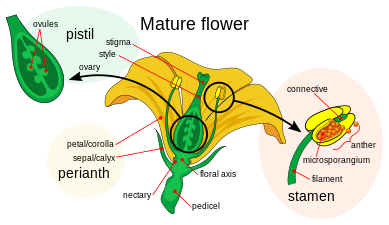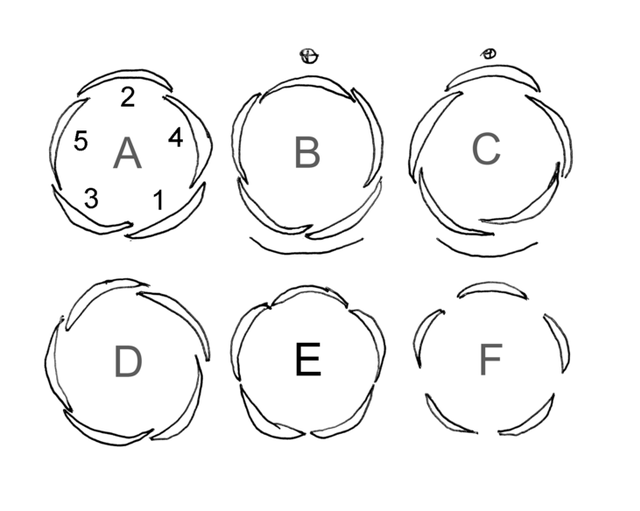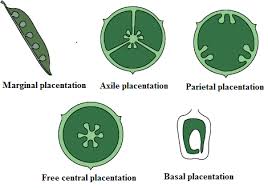INTRODUCTION
- The flower is the reproductive unit in the angiosperm. It is a modified shoot, meant for sexual reproduction. It consists of four whorls which are successively arranged on the thalamus or receptacle.
- Thalamus is the swollen end of the predicel or the stalk.
- The four whorls present in a flower are calyx, corolla, androecium, and gynoecium.
- The calyx and corolla are non-essential ,accessory organs and androecium and gynoecium are the reproductive organs of a flower (Essential whorls).
- In some flower like lily, the calyx and corolla are not distinct and are termed as perianth (tepal).
- The flowering plants, facilitating the crucial process of pollination. Through the collaborative relation between flowers and their pollinators – be it insects, birds, bats, or even the wind – these botanical gems ensure the continuation of plant species, while also sustaining entire ecosystems.
- Each species of flower boasts its own unique floral anatomy, adapted through millennia of evolution to suit diverse environmental niches and reproductive strategies.

Terminology used w.r.t The flower
Bisexual flower- A bisexual flower contains both male (stamen) and female (pistil) reproductive organs within the same structure.
Unisexual flower- A unisexual flower contains either male (stamens) or female (pistil) reproductive organs, but not both, within a single structure.
Tetramerous flower– A tetramerous flower has floral parts in multiples of four, a pentamerous flower has floral parts in multiples of five, and a bracteate flower has modified leaves near its base.
Pentamerous flower- A pentamerous flower has floral parts, such as petals or sepals, arranged in multiples of five.
Bracteate flower– A bracteate flower has modified leaves, called bracts, near its base.
Ebracteate– An ebracteate flower lacks modified leaves, called bracts, near its base.
Symmetry of The flower
- The symmetry of a flower refers to its arrangement of floral parts, such as petals, sepals, and reproductive organs, relative to an imaginary axis.
Flower symmetry can be broadly categorized into two types:
Radial Symmetry (Actinomorphic): Flowers with radial symmetry have their floral parts arranged symmetrically around a central point, similar to spokes on a wheel. These flowers can be divided into equal halves in multiple planes, typically exhibiting multiples of 3 floral parts (e.g., 3, 6, 9, etc.). Examples include lilies and buttercups.
Bilateral Symmetry (Zygomorphic): Flowers with bilateral symmetry have their floral parts arranged asymmetrically along a single plane, creating a mirror image when divided along that plane. These flowers often have distinctive “left” and “right” halves, with certain floral parts being larger or differently shaped on one side than the other. Examples include orchids and snapdragons.
Additionally, some flowers may exhibit intermediate or modified forms of symmetry, combining elements of both radial and bilateral symmetry
Position of floral parts on thalamus
- A hypogynous flower is one where the sepals, petals, and stamens are attached to the receptacle at the base of the ovary, and the ovary is positioned superior (above) the attachment point. This means that the sepals, petals, and stamens are below the ovary. This arrangement is characteristic of many flowering plants and is considered the most common floral arrangement. Examples of hypogynous flowers include those of roses, lilies, and apples.
- A perigynous flower is one where the sepals, petals, and stamens are attached to the rim of a cup-like structure called the hypanthium, and the ovary is positioned within or partially fused with the hypanthium. In perigynous flowers, the ovary is not completely inferior or superior, but rather partially inferior. This means that while the sepals, petals, and stamens appear to be inserted around the rim of the hypanthium, the ovary is situated within the hypanthium, but not necessarily at its very base. Examples of perigynous flowers include those of roses, apples, and cherry blossoms.
An epigynous flower is one where the sepals, petals, and stamens are attached above the ovary, which is situated at the base of a floral structure known as the receptacle. In this arrangement, the ovary is said to be inferior because it is positioned below the attachment point of the other floral parts. The sepals, petals, and stamens appear to arise from the top of the ovary, giving the impression that they are inserted on top of it. This floral arrangement is characteristic of many flowering plants, including members of the Asteraceae (daisy family) and Rosaceae (rose family). Examples of epigynous flowers include those of apples, strawberries, and daisies.
Parts of The flower
- The typical flower consists of several parts, each with its own function
Here are the main parts of a flower:
Sepals: These are the outermost parts of the flower, usually green and leaf-like. Sepals protect the flower bud before it blooms. Collectively, the sepals are called the calyx.
Petals: These are the colorful, often scented parts of the flower that attract pollinators like insects or birds. Collectively, the petals are called the corolla.
Stamens: These are the male reproductive organs of the flower. Each stamen typically consists of a filament (stalk) and an anther (head), where pollen is produced.
Pistil/Carpel: This is the female reproductive organ of the flower. It consists of several parts:
- Stigma: The stigma is the sticky or feathery tip of the pistil where pollen is received.
- Style: The style is a slender tube-like structure that connects the stigma to the ovary.
- Ovary: The ovary is the swollen base of the pistil that contains ovules, which develop into seeds after fertilization.
Ovules: These are the structures within the ovary that contain the female reproductive cells (eggs). After fertilization, ovules develop into seeds.
Receptacle: This is the swollen part at the base of the flower where all the floral parts are attached.
These parts work together in the reproductive process of the plant, facilitating pollination, fertilization, and seed production. Each part
plays a crucial role in ensuring the continuation of the plant species.
Aestivation
Aestivation refers to the arrangement of floral parts such as sepals, petals, or even entire flower buds before they open. It’s similar to the way petals are arranged in a bud before a flower blooms. Aestivation patterns vary among different plant species and can be important for protecting the delicate reproductive parts of the flower bud and facilitating efficient pollination.
There are several types of aestivation patterns:
Valvate: The floral parts in this arrangement are simply touching or slightly overlapping at the margins, but not folded or rolled.
Twisted: The floral parts are overlapping, with one margin inside and the other outside in a twisted fashion. This can be either clockwise (dextrorse) or counterclockwise (sinistrorse).
Imbricate: The floral parts overlap like roof shingles, with one edge of each part overlapping the adjacent one and the other edge being overlapped by another part.
Vexillary (papilionaceous): This is a specialized type of aestivation found in some flowers, particularly those of the pea family (Fabaceae). In this arrangement, one petal (the standard) is fully outside, while two lateral petals (wings) partially overlap it, and two bottom petals (keel) are completely enclosed within the others.
Aestivation is an important floral characteristic and can provide clues about a plant’s evolutionary relationships, as well as its ecological interactions with pollinators.
Lorem ipsum dolor sit amet, consectetur adipiscing elit. Ut elit tellus, luctus nec ullamcorper mattis, pulvinar dapibus leo.

Androecium
- “Androecium” is indeed another term for the male reproductive part of a flower, specifically encompassing all the stamens collectively within a flower. The androecium includes the stamens, each of which typically consists of a filament and an anther. The anther is where pollen, containing male gametes, is produced. The androecium is essential for the reproduction of flowering plants through the process of pollination.
Adhesion of stamen
- Adhesion of stamens refers to the fusion of the filaments, typically forming a tube or column. This fusion can affect the accessibility of reproductive organs and influence pollination. Degree of adhesion varies among plant species, impacting their reproductive biology
Gynoecium
- The gynoecium is the female reproductive part of a flower, consisting of one or more carpels. Each carpel typically comprises three main parts: the stigma (which receives pollen), the style (a slender stalk), and the ovary (where ovules develop into seeds after fertilization).
Cohesion of carpels: - Apocarpous refers to a gynoecium composed of separate, unfused carpels in a flower.
- Syncarpous describes a gynoecium where carpels are fused together to form a single structure in a flower.
Placentation
Placentation refers to the arrangement and attachment of ovules within the ovary of a flower.
- Marginal- Placentation refers to the arrangement and attachment of ovules within the ovary of a flower.
- Axile- Axile placentation describes a type where the ovules are attached to a central column within the ovary.
- parietal-Parietal placentation involves ovule attachment along the inner wall of the ovary.
- Free central- Free central placentation involves ovules attached to a central column within the ovary, not connected to the ovary wall.
- Basal-Basal placentation describes ovules attached at the base of a simple or compound ovary.

Funfact
- The Titan Arum, or “corpse flower,” is the world’s largest unbranched inflorescence.
- It can grow over 10 feet tall.
- It emits a foul odor like rotting flesh.
- This smell attracts pollinators like flies and beetles.
- Despite its stench, it’s a fascinating sight for botany enthusiasts.
- People often flock to botanical gardens to witness its rare bloom.
- Its massive size and pungent scent make it a unique marvel of nature.
- The Titan Arum’s bloom is a spectacle, but it only lasts a couple of days.
- After blooming, it retreats back into dormancy until its next cycle.
- This unusual flower continues to captivate and intrigue people around the world.
- The morphology of a flowering plant refers to its physical structure and form, including its roots, stems, leaves, flowers, and reproductive organs.
- The main parts of a flower include the petals (attract pollinators), sepals (protect the bud), stamen (male reproductive organ producing pollen), and pistil (female reproductive organ containing the ovary).
- Flowers can vary in structure based on factors such as size, color, number of petals, arrangement of reproductive organs, and scent, which are influenced by evolutionary adaptations and ecological niches.
- Petals serve to attract pollinators such as bees, birds, and insects by providing visual cues and sometimes scent. They also protect the reproductive organs within the flower.
- Flowers can be classified based on factors like symmetry (e.g., radial or bilateral), arrangement of reproductive organs (e.g., perfect or imperfect flowers), and inflorescence type (e.g., solitary or clustered flowers).